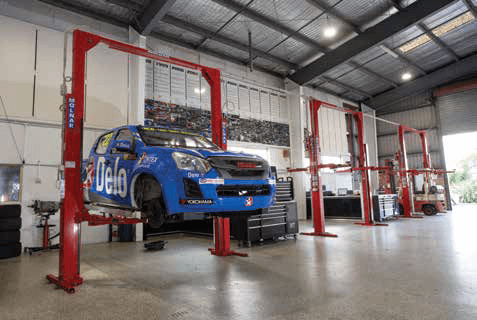The former home of Stone Brothers Racing now houses Ross Stone’s latest racing adventure.
On the outer fringes of Queensland’s Gold Coast is something of a dream factory. Here, from the late 1990s up until 2012, Stone Brothers Racing (SBR) churned out some of the most memorable and successful V8 Supercars racers even seen. Erebus Motorsport took the team over in 2012 and leased the giant workshop, before relocating to Melbourne a few years later. Following another short-term lease, the much-loved workshop was ready for a new venture, and New Zealander Ross Stone one half of the Stone Brothers – moved his Ross Stone Racing (RSR) venture into the hallowed ground. At this very workshop, SBR built Marcos Ambrose Ford BA Falcons to win the Supercars Championship in 2003 and 2004, and Russell Ingall the same for his 2005 triumph.
It certainly doesn’t have the buzz of its heyday when some 63 workers filled the space and winning racecars were being built, developed or repaired on site. There was also a shop across the road where engine building and dyno tuning would happen, but today things are a bit less hectic. No less professional though. The main workshop boasts the organised and clean nature you typically associate with successful racing teams, and RSR’s current racer is getting meticulous attention.
RSR runs an Isuzu D-Max in the ECB SuperUtes Series, and it’s clear the Stone name hasn’t forgotten how to win. Two victories this season plus solid finishes elsewhere sees its driver, Tom Alexander, lead the championship. This is no doubt helped by the boss still being a very hands-on motorsport man. “He drove the truck all the way to Perth (from Gold Coast) for the races there,” said race mechanic Ben Syron. “And he still gets his hands dirty. He still loves it.”
Fascinating aspects of race workshops are the trophies, memorabilia and framed photos. RSR has more than most thanks to its current success and that of SBR. One of Russell Ingall’s rear wheels from his championship-winning burnout is a frayed treat, there are Gold Coast V8 Supercars surfboard trophies on the wall, giant pole position winners’ cheques and triumphant pictures of race cars from across the years.
The sheer size of the 1000sq m workshop facility would be the envy of any race team. Ross Stone said when the workshop was first being built “the grand plan was to have 15 people working there and two cars. Not much later we’d bought another two factories, had 63 people working there and 12 cars.”
Such numbers are far less today, but mechanic Ben proves the attention to detail remains. “After a race the truck is unpacked and we work out what panels need replacing and which stickers need re-done,” he said. “Crack test items are removed, cleaned and sent off for testing and the ute is thoroughly cleaned. I’ll check the clutch, send the gearbox away if I have to, and I’ll see how straight the ute is. I’ll focus on any areas that may have copped a hit, look at the pedal box, make sure there are no leaks and go over the lines for any nicks.”
On our visit the engine was out too, ready to head to the dyno for more tuning.
RSR fabricate their own equipment in-house where possible – that’s just the mindset of a good race team. “It’s cheaper and exactly suited to what we’re doing,” I’m told. “We streamline everything to make it as useable as possible.”
Looking around, a separate area houses a spare ute chassis, an old V8 Supercar ready for restoration back to championship-winning specification, and numerous body panels, wheels, tyres and seats. In one corner sits a pile of bent Isuzu D-Max racing bumpers, evidence of some nose-to-tail scuffles in recent rounds.
On one of the many workshop hoists sits Chris Formosa’s bright orange General Lee-inspired Dodge Challenger from the TA2 Muscle Car Racing Series.
His family’s Allgate Motorsport team leases space at RSR when required, and race mechanic Brett Bull was busy preparing this brutal muscle car, it’s sound shattering the workshop’s peace on startup.
Also housed within is Motorsport Brakes, which provides racers the likes of Circo and Winmax braking products, and then there’s an expert car restorer making use of another separate area he leases from RSR. “There are normally two Ford Ranger SuperUtes in here too that we have our arm around,” Ross said. Essentially, there are four businesses in one place here, making good use of this huge motorsport-orientated premises.
At present SuperUtes is the main focus of RSR. “It’s a good series, very market relevant,” said Ross. “Utes are so popular today in the sales race, and to have people like Isuzu involved in Australian motorsport where they couldn’t have been before is great.”
It’s clear Supercars Hall-of-Famer Ross is happy to be back at his familiar place of work – he said he got bored two weeks into a sabbatical taken when his work with Erebus Motorsport finished. He’s staying hands-on with the different challenges presented with running a diesel-powered double-cab ute rather than the V8 sedans of old, but the winning ways have remained a constant.
“The Grand Plan Was To Have 15 People Working There And Two Cars. Not Much Later We’d Bought Another Two Factories, Had 63 People Working There And 12 Cars.”






